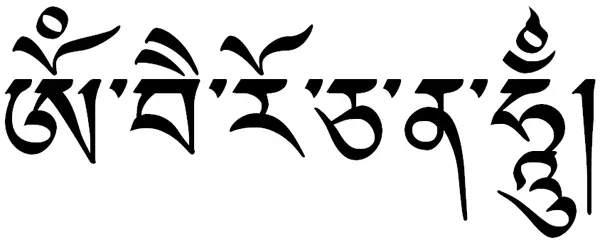This is the fundamental mantra of the primordial Buddha Vairocana, also
known as the Great Sun Tathagata. When Nagarjuna first developed the
esoteric school in India, its teachings were mainly comprised of mantras
such as this one that helps you to quickly transform the physical body. This
mantra is especially powerful in bringing about a purification
transformation of the physical body’s four great elements, and
transforming the four elements lays a strong foundation for cultivation
success. The mantra runs,
OHM AHH BEE LAH HUNG CHT!
The AHH sound in this mantra represents and acts upon the earth element
in the human body; the BEE sound represents and transforms the water
element; the LAH sound represents and transforms the body’s fire element;
the HUNG sound represents the wind element; and the CHT! sound
represents emptiness. In practicing this mantra, you are working on
transforming all the great elements of the human body, including your chi
(prana), energy meridians (nadi or mai), bright points (drops), chakras and
kundalini (tumo fire). The normal sequence in cultivation practice is to
transform the physical body’s wind element (chi) first, then its water
element (chi channels), then its fire element (kundalini warmth), and then
finally its earth element (bones) because it’s the densest and most resistant
to transformation. The sequence of progress requires over a decade to
complete, but the initial stages are greatly shortened through the use of this
mantra.
Vairocana is the primordial, fundamental Buddha of the universe.
His perfect and complete enlightenment was achieved endless eons ago, and
his practice is so comprehensive that it extends everywhere. If you want to
see Vairocana, you need only realize that everything we see, everywhere
we go is Vairocana’s body and every sound is Vairocana’s sound. To match
his stage of realization and to see what Vairocana perceives, you can even
imagine yourself as a projection of Vairocana as a form of cultivation.
When you get Tao, your mind is the same as Vairocana’s and all the other
enlightened Buddhas, for everyone shares the same enlightened nature.
In reciting his mantra, as with all other mantras, you seek a cessation of
ordinary mentation, which Buddhism calls “tying up the sixth
consciousness,” in order to arrive at the quiet and calm of samadhi. In most
forms of mantra practice, you try to tie the mind’s inner dialogue to the
mantra to get rid of all miscellaneous monkey-thoughts. When you
successfully tie the sixth consciousness (ordinary mind of meditation) to a
single object of focus, then you can arrive at the mental quiet of cessation
after which you must contemplate the state of quiet which you’ve
produced. So by chanting mantras and listening within, and then using
wordless insight wisdom to observe the state of quiet you produce, one can
quickly attain samadhi.
As to the method of chanting, the internal chanting is usually best,
though at times the verbal chanting may be better, depending upon your
situation. The choice of method is all up to what skillful means you need at
the moment to calm your mind. The Sandilya Upanishad states, “The
Vaikhari-Japa (loud mantra recitation) gives the reward as stated in the
Vedas, while the Upanshu-Japa (whispering or humming recitation similar
to the vajra chanting in Tantra) that cannot be heard by anyone, gives a
reward a thousand times more than the Vaikhari, but the Manasika-Japa
(mental chanting) gives a reward a myriad times more than the Vaikhari.”
When you can perform your mantra recitation, or japa, in conjunction with
rhythmic breathing while intently visualizing the form of a Buddha, deity,
or bright flame as in kundalini yoga, you can more quickly reach the stage
of one-pointedness and transform the physical body into a vehicle more
suited for cultivation.
Faq
What is the purpose of the Vairocana Mantra?
The Vairocana Mantra serves as a fundamental tool for transforming the physical body’s four great elements, purifying them, and establishing a strong foundation for spiritual cultivation.
How is the Vairocana Mantra structured?
The Vairocana Mantra consists of the syllables: “OHM AHH BEE LAH HUNG CHT!” Each syllable corresponds to and transforms one of the four elements of the human body, along with a representation of emptiness.
What do the syllables of the Vairocana Mantra represent?
The “AHH” sound represents and acts upon the earth element, “BEE” represents and transforms the water element, “LAH” transforms the body’s fire element, “HUNG” represents the wind element, and “CHT!” represents emptiness.
How does the sequence of element transformation work in spiritual cultivation according to the text?
The sequence of element transformation typically starts with the wind element (chi), followed by the water element (chi channels), then the fire element (kundalini warmth), and finally, the earth element (bones).
What is the significance of chanting the Vairocana Mantra in spiritual practice?
Chanting the Vairocana Mantra, like other mantras, aims to quiet the mind and lead to samadhi, the state of deep meditative absorption. It helps to transcend ordinary mental processes and attain a state of inner calm and focus.
How does the text describe the attainment of samadhi through mantra practice?
By chanting mantras and focusing the mind on a single object, one can quiet the ordinary mental chatter and attain samadhi. After achieving cessation, practitioners contemplate the state of quietness they’ve produced.
What is the role of the sixth consciousness in mantra practice?
The sixth consciousness, the ordinary mind of meditation, is sought to be tied to a single object of focus, such as a mantra, to eliminate distracting thoughts and achieve mental stillness.
What is emphasized regarding the method of chanting the Vairocana Mantra?
The text suggests that both internal chanting and verbal chanting have their benefits, depending on the practitioner’s situation and needs for calming the mind.
According to the Sandilya Upanishad, how does the reward of mantra recitation vary based on the method?
The Upanishad suggests that mental chanting (Manasika-Japa) yields the highest reward, followed by whispering or humming recitation (Upanshu-Japa), and then loud recitation (Vaikhari-Japa).
What does the text say about rhythmic breathing and visualization in conjunction with mantra recitation?
Engaging in rhythmic breathing and visualizing a Buddha, deity, or flame during mantra recitation helps achieve one-pointedness of mind and accelerates the transformation of the physical body for spiritual cultivation.
How does the text explain the concept of seeing Vairocana everywhere?
The text suggests that perceiving Vairocana involves recognizing that everything we see and hear is an expression of his presence. By aligning one’s mind with the enlightened nature, one can perceive Vairocana’s essence in all phenomena.
What is the implication of realizing that everything we see and hear is Vairocana’s body and sound?
Realizing this implies recognizing the interconnectedness and unity of all existence, where every phenomenon reflects the essence of enlightenment and the primordial Buddha.
How does one match the stage of realization of Vairocana according to the text?
To match Vairocana’s stage of realization, practitioners can imagine themselves as projections of Vairocana, aligning their minds with his enlightened nature.
What does the text suggest about the enlightened nature shared among individuals?
The text suggests that when one attains Tao, their mind becomes aligned with the enlightened nature shared by all Buddhas, including Vairocana.
What role does wordless insight wisdom play in mantra practice according to the text?
Wordless insight wisdom is used to observe the state of quietness produced through mantra practice, allowing practitioners to deepen their understanding and realization of the meditative state.
How long does the sequence of progress in element transformation typically take according to the text?
The sequence of progress in element transformation requires over a decade to complete, although the initial stages can be shortened through the use of the Vairocana Mantra.
Why is the earth element transformed last in spiritual cultivation?
The earth element, being the densest and most resistant to transformation, is typically transformed last in spiritual cultivation.
What are some elements transformed through the practice of the Vairocana Mantra aside from the physical body’s elements?
The practice of the Vairocana Mantra also transforms aspects such as chi (prana), energy meridians (nadi or mai), bright points (drops), chakras, and kundalini (tumo fire).
How does the text describe the comprehensive nature of Vairocana’s practice?
Vairocana’s practice extends everywhere and encompasses all aspects of existence, reflecting the depth and breadth of his enlightenment.
What is the significance of the mantra’s representation of emptiness (CHT!)?
The representation of emptiness in the mantra symbolizes the transcendence of conceptual limitations and the realization of ultimate truth beyond form and perception.
How does the Vairocana Mantra contribute to the transformation of the physical body for spiritual cultivation?
By working on transforming the physical body’s elements, the Vairocana Mantra lays a strong foundation for cultivation success, facilitating the purification and refinement of the practitioner’s being.
What does the text advise regarding the choice between internal and verbal chanting of the mantra?
The choice between internal and verbal chanting depends on the practitioner’s need for calming the mind, with both methods offering benefits based on the situation.
What is the role of the breath and visualization in mantra practice, according to the text?
Rhythmic breathing and visualization help enhance focus and concentration during mantra practice, facilitating the attainment of one-pointedness of mind and deeper states of meditation.
How does the text suggest practitioners attain samadhi through mantra practice?
By quieting the mind and tying the sixth consciousness to the mantra, practitioners can achieve mental stillness and contemplative insight, ultimately leading to the state of samadhi.




